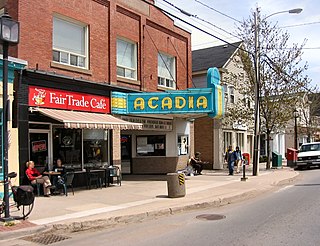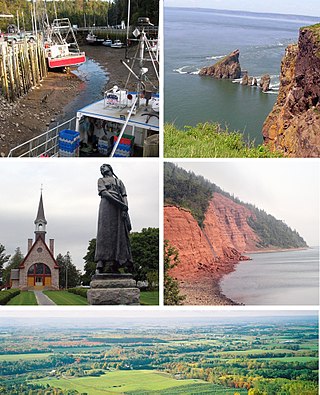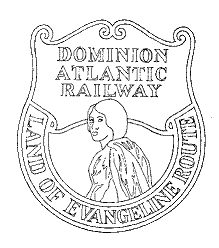
The Annapolis Valley is a valley and region in the province of Nova Scotia, Canada. It is located in the western part of the Nova Scotia peninsula, formed by a trough between two parallel mountain ranges along the shore of the Bay of Fundy. Statistics Canada defines the Annapolis Valley as an economic region, composed of Annapolis County, Kings County, and Hants County.

Wolfville is a Canadian town in the Annapolis Valley, Kings County, Nova Scotia, located about 100 kilometres (62 mi) northwest of the provincial capital, Halifax. The town is home to Acadia University and Landmark East School.

Kings County is a county in the Canadian province of Nova Scotia. With a population of 62,914 in the 2021 Census, Kings County is the third most populous county in the province. It is located in central Nova Scotia on the shore of the Bay of Fundy, with its northeastern part forming the western shore of the Minas Basin.

Marine Atlantic Inc. is an independent Canadian federal Crown corporation which is mandated to operate ferry services between the provinces of Newfoundland and Labrador and Nova Scotia.

Channel-Port aux Basques is a town at the extreme southwestern tip of Newfoundland fronting on the western end of the Cabot Strait. A Marine Atlantic ferry terminal is located in the town which is the primary entry point onto the island of Newfoundland and the western terminus of the Newfoundland and Labrador Route 1 in the province. The town was incorporated in 1945 and its population in the 2021 census was 3,547.

The Minas Basin is an inlet of the Bay of Fundy and a sub-basin of the Fundy Basin located in Nova Scotia, Canada. It is known for its extremely high tides.

The Newfoundland Railway was a narrow-gauge railway that operated on the island of Newfoundland from 1898 to 1988. With a total track length of 906 miles (1,458 km), it was the longest 3 ft 6 in narrow-gauge system in North America.
Terra Transport (TT) was the name for the Newfoundland Transportation Division, a wholly owned subsidiary of Canadian National Railway (CN), created in 1979 as a means to organize the company's operations on Newfoundland.

The Dominion Atlantic Railway was a historic railway which operated in the western part of Nova Scotia in Canada, primarily through an agricultural district known as the Annapolis Valley.
New Minas is a Canadian village located in the eastern part of Kings County in Nova Scotia's Annapolis Valley. As of 2011, the population was 5,135.

Grand-Pré is a Canadian rural community in Kings County, Nova Scotia. Its French name translates to "Great/Large Meadow" and the community lies at the eastern edge of the Annapolis Valley several kilometres east of the town of Wolfville on a peninsula jutting into the Minas Basin surrounded by extensive dyked farm fields, framed by the Gaspereau and Cornwallis Rivers. The community was made famous by Henry Wadsworth Longfellow's poem Evangeline and is today home to the Grand-Pré National Historic Site. On June 30, 2012, the Landscape of Grand-Pré was named a World Heritage Site by UNESCO.

Parrsboro is a community located in Cumberland County, Nova Scotia, Canada.

The Ship's Company Theatre is a professional theatre company based in Parrsboro, Nova Scotia.
Saint John Shipbuilding was a Canadian shipbuilding company located in Saint John, New Brunswick. The shipyard was active from 1923 to 2003.
Kingsport is a small seaside village located in Kings County, Nova Scotia, Canada, on the shores of the Minas Basin. It was famous at one time for building some of the largest wooden ships ever built in Canada.
Kings County was a four-masted barque built in 1890 at Kingsport, Nova Scotia on the Minas Basin. She was named to commemorate Kings County, Nova Scotia and represented the peak of the county's shipbuilding era. Kings County was one of the largest wooden sailing vessels ever built in Canada and one of only two Canadian four-masted barques. At first registered as a four-masted full-rigged ship, she was quickly changed to a barque after her June 2 launch. More than three thousand people from Kings and Hants counties attended the launch. She survived a collision with an iceberg on an 1893 voyage to Swansea, Wales. Like many of the large wooden merchant ships built in Atlantic Canada, she spent most of her career far from home on trading voyages around the world. In 1909, she returned to the Minas Basin for a refit at Hantsport and loaded a large cargo of lumber. In 1911 she became the largest wooden ship to enter Havana Harbour when she delivered a cargo of lumber and was briefly stranded. She was lost a few months later on a voyage to Montevideo, Uruguay when she ran aground in the River Plate. Too damaged to repair, she was scrapped in Montevideo where her massive timbers were visible for many years.

The Windsor and Annapolis Railway (W&AR) was a historic Canadian railway that operated in Nova Scotia's Annapolis Valley.
The Flying Bluenose was a Canadian luxury passenger train operated by the Dominion Atlantic Railway between Halifax, Nova Scotia and Yarmouth, Nova Scotia from 1891 to 1936. It was a boat train scheduled to connect with passenger steamships to Boston and ran only during the summer months.

Canada was a full-rigged ship built in 1891 at Kingsport, Nova Scotia on the Minas Basin and was the largest sailing ship operated in Canada when launched in 1891. Canada was built and owned by Charles Rufus Burgess of nearby Wolfville, Nova Scotia. Despite the decline in wooden shipbuilding, Burgess saw that there was still potential for very large wooden sailing ships to make profits in the twilight days of the wooden sailing ship era. He had built the barque Kings County, the previous year, the largest four-masted barque ever built in Canada. Burgess planned to make Canada to be the largest sailing ship ever built in Canada, but damage, during harvesting, to a timber intended for the keel caused her length to be trimmed by ten feet making Canada slightly smaller than the ship William D. Lawrence built in 1874. However, as the William D. Lawrence had been sold to Norwegian owners and renamed in 1883, the ship Canada still claimed the honour of being the largest sailing ship under the Canadian flag at the time of her launch. Between 75 and 150 men were employed in building the ship. Canada was designed by master builder Ebenezer Cox who was in charge of the Burgess Shipyard in Kingsport where he had built ships since the 1860s and was regarded at the time to have built more ships than any man in Canada. The construction cost $111,000. Her interior included a finely outfitted captain's cabin, finished in walnut, ash and rosewood with a full dining room, office and bathroom. Her launch at noon on July 6, 1891 attracted 5,000 people from all across Western Nova Scotia, brought by multiple special trains run by the Cornwallis Valley Railway. It was regarded as the biggest event in the history of the village. A tug took the completed hull of Canada from the launch at Kingsport to Saint John, New Brunswick where the masting, rigging and outfitting was completed at the Customs House Wharf. Her immense size attracted hundreds to the Saint John waterfront to see Canada depart on September 1, 1891 for her maiden voyage, carrying with a cargo of lumber worth $144,109 bound for Liverpool, England. Classed A1 by Lloyd's Register for 14 years, Canada made several fast passages between South America and Australia. However by 1900, the ship was facing stif competition for cargoes from the growing numbers of general cargo steamships. Canada was converted to a gypsum barge in 1910, carrying gypsum from Windsor, Nova Scotia to Staten Island, New York for the Gypsum Transportation Company of New York. She was towed a final time from New York to Portland, Maine in 1926 where she was broken up.

MV Abegweit were icebreaking railway, vehicle, and passenger ferries which operated across the Abegweit Passage of Northumberland Strait, connecting Borden-Carleton, Prince Edward Island to Cape Tormentine, New Brunswick. There were two vessels named Abegweit that serviced this route between 1947 and 1997.














